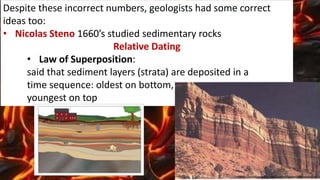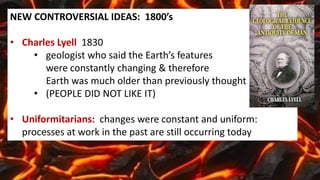Earth history 1
- 1. EARTH HISTORY 1: Geological Changes ppt. by Robin D. Seamon HOOK VIDEO: Ian Stewart: Volcanoes (50 min)
- 2. • Earth is dynamic (changing) • Heat from the center • Energy from the Sun INSIDE: • Decay of radioactive isotopes • The release of this heat causes: • churning of the molten rock inside • Release of heat through cracks/vents in the crust • Convection causes plates of crust to move about
- 3. OUTSIDE: • Sun’s Energy on the atmosphere and water make: • Wind • Currents • Evaporation- Water Cycle • This causes weather & larger patterns of climate • It influences Water Cycle which controls weathering, erosion, & deposition http://www2.mps.mpg.de/projects/sun-climate/se_body.html
- 4. INSIDE • 99% of rock inside the Earth is greater than 2,000˚F (radioactive decay generates the heat) • Crust: (0.2 – 1.1 % crust or 4-43 miles deep) 700˚F- 1,500˚F • Mantle: (45 % interior) hot magma 7,000˚F • Core: (54% of interior) Fe, Ni 10,000˚F
- 5. COMPOSITION: • Scientists study earthquake waves to determine what’s inside • Pattern of waves through the Earth shows something dense in the center • Fe (iron) fits this description & also explains magnetic field http://www.indiana.edu/~geol105/images/gaia _chapter_3/seismic.htm
- 7. • Geothermal: relating to heat inside the earth DEEPEST man-made hole: • Kola Superdeep borehole- NW Russia • 40,000 ft & then too hot to dig more Crust 21 miles deep in Baltic Region At 7.4 miles, 300˚F Average oil well is ~ 1 mile Scientists try to harness this geothermal Energy for renewable Energy source
- 8. OUTSIDE • Plate Tectonics: plates move about ½” to 3” a year • Theory that the Earth’s lithosphere is composed of 10+ plates that fit together like a puzzle http://www.bucknell.edu/x17758.xml
- 11. • The plates move slowly on the upper mantle (asthenosphere) http://kids.britannica.com/comptons/art-156130/A-diagram-shows-the-relationship- between-volcanic-activity-and-Earths VIDEO: Plate Tectonics (1.5 min)
- 12. • Movement is caused by convection inside the Earth • Hot goes up, cold goes down- • plates are along for the ride • Continental Drift: in the 1900’s scientists realized the plates were moving, but didn’t know why (Alfred Wegner) 1. *VIDEO: The Early Earth & plate tectonics-National Geo (5min) 2. VIDEO: Plate Tectonics: A documentary (7 min)
- 13. FAULTS LAB
- 14. Spain FAULTS LAB
- 15. Landforms & Forces that Made Them Constructive or Destructive? Constructive force: forces that build up new crust Destructive Forces: forces that destroy crust Sporadic or Gradual? Sporadic event: event happened quickly and suddenly Gradual event: event happened over a long period of time
- 16. • Volcanoes: sometimes the heat can escape through vents at the surface; magma & hot gases from inside are released until pressure is abated • Largest- Mauna Loa, Hawaii 18,000square miles • Big eruptions occur several times/Century • Shield volcano: layers of lava released from non-explosive eruptions (Mauna Kea, Hawaii)
- 17. • Cinder cone volcano: pyroclastic material- dust & ash explodes out (Paracutin, Mexico) Composite volcano: pyroclastic explosions followed by slower, longer flowing-lava (Mt. St. Helens
- 18. • Earthquakes: tension builds up at plate boundaries until the plates slip & tension is released- we feel earthquakes Tsunami: when earthquake happens under the ocean
- 19. EVIDENCE in CRUST • Uplift: places on the crust that bulge upwards because of pressure underneath • can help predict future earthquakes or eruptions http://www.panoramio.com/photo/15735758 http://bc.outcrop.org/GEOL_B10/lecture18.html
- 20. • Predicts tension at a divergent boundary • Predicts loss of material below • Subsidence: places on the crust that are sinking down in elevation
- 21. • Rebound: places on the crust that rise in elevation when a heavy weight is removed • Ice sheet melts • During droughts when water table is emptied • Heavy building is removed http://bprc.osu.edu/education/rr/webex/WebExGridLinks2Pg6.html
- 22. FAULTS & BOUNDARIES • Compression: two plates are pushed together at convergent boundaries Results in: • Subduction (cooler oceanic crust goes beneath warmer continental crust) • Folding (crust folds into mountains) • Faulting (crust pushes up or falls in block mountains) • Hanging wall • Footwall • earthquakes ADVANCE
- 23. Folded Mountains http://freddoty.com/folded-mountains near the Sullivan River in the Canadian Rockies The Cape Fold Belt Mountains http://www.geocaching.com/geocache/GC2CEJP_steytlerville-arch?guid=ff36205a-b979-422c-8266-f7f83ec4d884 BACK
- 25. BACK
- 27. • Tension : two plates are pulled apart at divergent boundaries Results in: • Sea-floor spreading (new sea floor is made) • Trenches or rifts (gashes made from the pulling apart) • Subsidence or faulting • earthquakes Thingvellir Breach, Iceland VIDEO: Sea Floor Spreading- Nye (3 min)
- 28. • Shear : two plates slide past each other horizontally in a transform boundary Results in: • Ridges • earthquakes San Andreas Fault, Ca
- 29. ROCK CYCLE • Rock Cycle: process by which new crust is continually being recycled At plate boundaries: -pull apart (making new crust) -push together (forming mountains) -subduct (under other plates) http://www.perfecthomepictures.com/277773-gabbro-igneous-intrusive-phaneritic
- 30. PROCESSES: 1. crystallization 2. heat & pressure 3. weathering/erosion/deposition 4. Compaction/cementation 5. Melting -VIDEO: Rock types & Rock Cycle (4min) -ACTIVITY LINK http://www.passmyexams.co.uk/GCSE/physics/rock-cycle.html
- 31. • Igneous rock: rock formed from cooling magma • Intrusive igneous: crystalizes inside the earth slowly (hot in there) making larger crystals • Extrusive igneous: crystalizes fast outside the earth (cooler) making fewer crystals INTRUSIVE EXTRUSIVE granite gabbro basalt obsidian
- 33. • Metamorphic rock: rock is under heat & pressure for a long time so that it chemically changes into another type of rock granite gneiss sandstone quartzite slate schist coal diamond
- 35. • Sedimentary rock: rock is formed over time by sediments being compacted together • Hold fossils that describe Earth’s early life forms • The strata (layers) help determine relative age of rock Clay sediment makes shale Sand sediment makes sandstone Mineral deposits in water make limestone Dead plants & animals make fossil fuels Gravel, shell, & fossils make conglomerate
- 37. HOW OLD IS THE EARTH? • Age of the Earth has been debated for Centuries TRADITIONAL VIEW: • At first scientists thought that the Earth was formed & has been cooling ever since (not true)… led to wrong numbers • They thought the earth was static & that only catastrophes led to changes • We now know earth has a heating mechanism inside causing changes in the shape of the crust!
- 38. Despite these incorrect numbers, geologists had some correct ideas too: • Nicolas Steno 1660’s studied sedimentary rocks Relative Dating • Law of Superposition: said that sediment layers (strata) are deposited in a time sequence: oldest on bottom, youngest on top http://www.angelfire.com/az3/mohgameil/physical.html
- 39. • Unconformity places where no sediments were preserved (erosion) for a time; separates different ages Angular unconformity
- 41. • Principle of original horizontality: said that layers of sediment are originally deposited horizontally • (therefore if they aren’t, something moved them after they were laid down) • Principle of cross-cutting relationships: says that a feature is younger than the feature it cuts across
- 42. • William Smith 1790’s • Hypothesized that if two layers of rock at different locations contain similar fossils, then rocks must be the same age • Index fossils: fossils used to determine relative age of rocks
- 43. NEW CONTROVERSIAL IDEAS: 1800’s • Charles Lyell 1830 • geologist who said the Earth’s features were constantly changing & therefore Earth was much older than previously thought • (PEOPLE DID NOT LIKE IT) • Uniformitarians: changes were constant and uniform: processes at work in the past are still occurring today
- 45. MODERN DATING METHODS 1900 Radioactivity discovered (unstable atoms) Absolute Dating • Radiometric dating using radioactive forms of elements in rock to determine the age of the rock or fossil
- 46. How it works: • Atoms in an element have the SAME number of protons • Sometimes their number of neutrons is different: isotopes • Radioactive: unstable isotopes break down (decay) over time • Decay happens at steady rate for each element • Half-life: time it takes for ½ of the sample to decay (scientists know for each element) • Compare amount of parent isotope to daughter isotope to know age of rock/fossil Amount Parent isotope Amount Daughter isotope AGE OF ROCK/FOSSIL
- 47. 50 % 25 % 25 % 25 % 50 % 100 % 50 % PERCENTAGES 1/2 25 % 1/4 1/4 1/2 1 whole 1/2 FRACTIONS RADIOACIVE DECAY
- 48. Common types: Potassium-Argon (> 1000,000 ya) Uranium-Lead (> 10 million ya) Rubidium-Stronium (>10 million ya) Carbon-14 (in fossils) VIDEO: Radiometric Dating (5 min)
- 49. VIDEO 3: Radiometric dating Geologic Time 5 min
- 50. Magnetic reversals: evidence is left in the seafloor along divergent boundaries that the Earth’s poles have reversed randomly many times in Earth’s past • New igneous rock, if it has metal in it will magnetize • There are places in the seafloor’s ‘record’ that are opposite to Earth’s current field • This pattern is also seen in seafloor core samples • Important means of dating for metamorphic & igneous rock samples (no fossils)
- 51. • If rock becomes molten, radioactivity escapes & we can’t determine age • Rock Cycle??? • How old is the Earth? • We use- • Samples from Earth (oldest Zircon crystal found so far in Australia) • Samples from meteorites that hit Earth • Samples from the moon • Date the Sun based upon luminosity & Energy as compared to other stars • Ice core data…
- 52. … So most scientists agree that with current technology, the Earth is… 4.5 billion years old VIDEO: COSOMOS- The Clean Room (45 min) VIDEO 1: Big Idea Age of the Earth 5 min VIDEO 2: History of Earth in 5 ½ minutes 5.5 min VIDEO 3: World’s Most Asked Questions-How old is the Earth? (2:50)




















































